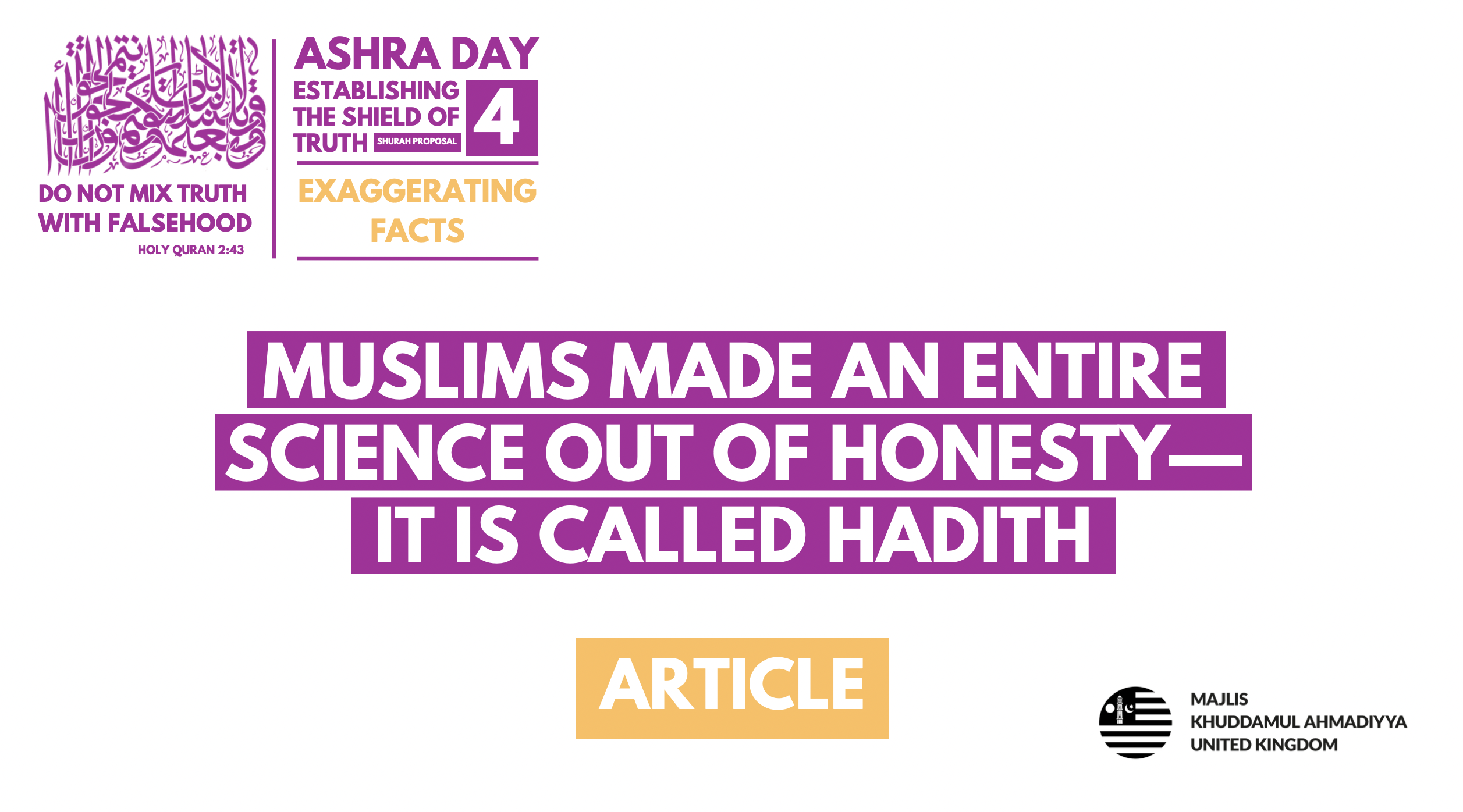
Muslims Made an Entire Science out of Honesty—it is called Hadith
Honesty has been a cornerstone of Islamic belief since its inception over 1,400 years ago. We are all aware of how the Holy Prophet Muhammad (sa) was given the title of The Truthful by his nation owing to his special quality of being trustworthy and honest. Not only is truthfulness linked to the inception of Islam, but its strength can be found in the generations of Muslims after the early Companions.
How is it found? In the Ahadith and the way in which they were collected—a testament to the principle of honesty in Islam. The rigorous development of the science of Hadith not only teaches us about the place of truth in Islamic society but also about—the specific topic for Day 4 of the Truth Ashra—exaggerating facts.
The Ahadith are records of the sayings, actions, and conduct of the Holy Prophet Muhammad (sa) and they serve as a vital source of Islamic knowledge. To preserve the authenticity of these accounts, Muslim scholars pioneered a sophisticated methodology for verifying and transmitting information, elevating honesty into a systematic discipline.
The Importance of Hadith in Islam
For Muslims, the Holy Quran is the ultimate guide, but since the Holy Prophet Muhammad (sa) was the perfect example of how to put the Quranic teaching into practice, the Muslims who were born a few generations after the Companions wanted to ensure they held onto the narrations and memories of their beloved Prophet (sa) as seen and heard by the Companions.
However, since there were hardly any written records they had to rely on oral tradition. This transmission posed a unique challenge—how to ensure the authenticity of these narrations over generations. Thus was born a unique science.
Origins of the Science of Hadith
In the early years of Islam, the Companions of the Holy Prophet (sa) meticulously memorised and recorded his words and actions. As Islam expanded beyond the Arabian Peninsula, so did the challenge of ensuring the integrity of transmitting the words of the Holy Prophet (sa) exactly as they were said. To address this, scholars developed a rigorous system to authenticate Ahadith, known as Ilm al-Hadith, or literally the Science of Hadith.
This entire science is based on honesty and truth. It is remarkable that in some references we find that Hazrat Imam Bukhari (who compiled Sahih Bukhari) had collated hundreds of thousands of Ahadith. However, only a few thousands are actually part of his Sahih Bukari for the simple reason that he chose to include only those that, according to his research, were the most realiable and trustworthy.
Honesty in Methodology
The Science of Hadith exemplifies intellectual honesty. Scholars often travelled vast distances to verify a single narration, interviewing witnesses and cross-checking information with meticulous care. It is amazing to note that if an individual was known to be one who exaggerates facts, his transmission of hadith was not seen in the same way as those who held a status of saying that which was true and straight-forward.
This commitment to truth extended beyond religion; it laid the groundwork for principles that resonate with modern investigation. For example, the emphasis on verifying sources and maintaining a chain of custody mirrors contemporary practices in journalism, law, and historical research. By documenting their methods in exhaustive detail, Hadith scholars ensured their findings would be as accurate as possible.
Once Hazrat Imam Bukhari made a long journey in order to obtain a narration from someone. When he approached that individual, he saw that he was luring his donkey towards himself tricking it into thinking the owner had something for the donkey to eat when in reality he did not. Hazrat Imam Bukhari turned back on the spot, and did not even hear his narration.
Exaggerating Facts
Not only is the collection of Ahadith a proper science, but the Muslims who came after the Muslims who collated Ahadith, developed another science on how reliable narrators were. So you had a science emerge from a science. The study of Ahadith narrators is called Asma-ur-Rijal.
Conclusion
The development of the Science of Hadith reflects the profound commitment to complete and utter honesty and truth—absolute truth and accuracy. No exaggeration of facts was tolerated and personal piety of the narrators of Ahadith with regards to truth is the cornerstone of the books of Ahadith that we have with us today. Today the Islamic civilisation, like for centuries before, is shaped by truth and it benefits from it.
We are on Day 4 of the Truth Ashra which is part of the Establishing the Shield of Truth Shurah Proposal. Click here to view our Truth Hub page which is loaded with more content!